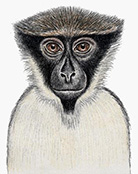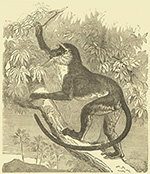Resource 4: Diana monkeys
![]() Background information / subject knowledge for teacher
Background information / subject knowledge for teacher
 |  |
Habitat
The Diana monkey is found in West Africa. It inhabits semi-deciduous mature forests.
Physical description
The Diana monkey has dark grey fur, with a brown or red back, white beard, chest and throat, and a black tail. It is named after the Roman goddess Diana because of the white stripe across its forehead, which resembles the shape of her bow. Length ranges from 45–55 cm, excluding its tail. Adults weigh between 4 and 7 kg. Their fur is short and sleek in appearance. Life span is around 20–30 years.
Behaviour
The Diana monkey lives in groups of five to up to 30 individuals but there is usually only one adult male and numerous females and young. Feeding and grooming is done in the safety of the middle to the high canopy of trees.
The Diana monkey has a wide range of alarm calls, with different sounds for different predators; it is a noisy presence in the forest.
Diet
The Diana monkey feeds mainly on fruit, leaves, flowers and insects.
Reproduction
In good conditions, adult females reproduce annually. Pregnancy lasts about five months and normally only a single infant is born.
Predators
The Diana monkey is preyed upon by crowned hawk-eagles, leopards, chimpanzees and humans.
Conservation status
The Diana monkey is regarded as endangered by the International Union for the Conservation of Nature and Natural Resources (IUCN). The chief danger is from habitat destruction (they are now virtually confined to coastal areas) and hunting for bush meat. Deforestation for farming has been the biggest factor in declining numbers.
Adapted from: Wikipedia, Website
Resource 3: History of technology



